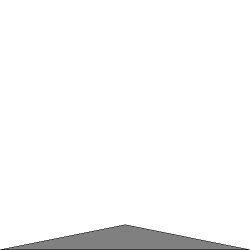
The function $g_n(x)$ becomes a sharp peak at $x=0$ for $n \rightarrow \infty$ and, geometrically, it certainly does not disappear or becomes zero. Instead, it seems that we get, in the end, what physicists know as a delta function. Informally: $$ \delta(x) = \begin{cases} 0 & \text{for } x \ne 0 \\ \infty & \text{for } x = 0 \end{cases} \qquad ; \qquad \int_{-\infty}^{+\infty} \delta(x) \, dx = 1 $$ Whatever definition might be the "rigorous" one, a delta function, roughly speaking, is just a very large peak near $x = 0$ with area normed to $1$. Furthermore, it is typical that the following function, triangular as well, is indeed supposed to converge to the delta function - instead of becoming zero - for $n \rightarrow \infty$ and nobody has any doubt about it. $$ D_n(x) = \begin{cases} n^2x + n & \text{if } -1/n \le x \le 0 \\ n - n^2x & \text{if } 0 \le x \le +1/n \\ 0 & \text{everywhere else} \end{cases} $$ The only thing that distinguishes $g_n(x)$ from $D_n(x)$ is that the maximum of the former is shifted an infinitesimal distance $\lim_{n \rightarrow \infty} 1/(2n)$ with respect to the maximum of the latter at $x=0$.
So it's easy to see that these functions become one and the same for $n \rightarrow \infty$: $$ \lim_{n \rightarrow \infty} g_n(x) = \lim_{n \rightarrow \infty} D_n(x) = \delta(x) $$ Therefore, in the end, we have two arguments that, unfortunately, also lead to different outcomes for the iterated limit.